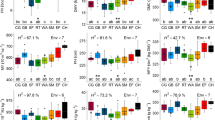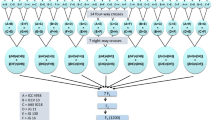Abstract
A doubled haploid method (DH) has been used to rapidly advance generations intriticale, and selections then made for high yielding homozygous lines. This study aimed at comparing the forage performance of DH populations produced from the BC1F1, TC1F1 and F2 generations with superior mid-generation progenies (BC1F3,TC1F3 and F4) derived from field selection. One hundred and sixty eight DH lines derived from anther culture of eight populations were used. The results of analysis of variance for plant weight (PW), and dry matter yield (DM) of triticale lines developed by the method of doubled haploidy and field selections showed that the differences between the two methods were not significant. Differences among the three type crosses(BC1F3, TC1F3, F4/BCF∞, TCF∞ and F∞), method × cross interaction, and among populations within methods × cross were significant for PW and DM. Unlike forage characters, no significant differences were obtained for grain yield (GY) in all sources of variations. However, DH lines generally had wider ranges for PW, DM, GY and total biomass (TB) than lines derived from field selections. The observations of higher forage and grain performances of several DH lines compared to their corresponding field-derived populations show that the forage and dual-purpose breeding of triticale DH lines by means of hydroponics and anther culture of individual-plant selections in early generation under greenhouse conditions is highly beneficial.
Similar content being viewed by others
References
Arzani, A. & N.L. Darvey, 1998. Assessment of Doubled Haploids andMid-Generation Population of Forage and Dual Purpose Triticale for Rust Resistance under Australian Conditions. In: P. Juskiw (Ed.), Proc 4th Intl Triticale Symp, Red Deer, Alberta, Canada, pp. 164–172.
Arzani, A. & N.L. Darvey, 2001. The effect of colchicine on triticale anther-derived plant: Microspore pre-treatment and haploidplant treatment using a hydroponic recovery system. Euphytica 122: 235–241.
Bjornstad, A. H. Skinnes, A.K. Uhlen, P. Marum & A.G. Maroy, 1993a. Comparison between doubled haploid lines produced by anther culture, the Hordeum bulbosum-method and lines produced by single seed descent in barley crosses. Euphytica 66: 135–144.
Bjornstad, A., H. Skinnes, A.K. Uhlen, P. Marum & A.G. Maroy, 1993b. Genetic marker segregations in doubled haploids in spring wheat crosses. Hereditas 118: 55–62.
Charmet, G. & G. Branlard, 1985. A comparison of androgenetic doubled-haploid, and single seed descent lines in triticale. Theor Appl Genet 71: 193–200.
Charmet, G.C., S. Bernard & M. Bernard, 1986. Origin of aneuploid plants obtained by anther culture in triticale. Can J Genet Cytol 28: 444–452.
Choo, T.M. 1981. Doubled haploids for studing the inheritance of quantitative characters. Genetics 99: 525–540.
de Buyser, J., Y. Henry & G. Taleb, 1985. Wheat androgenesis: cytogenetical analysis and agronomic performance of doubled haploids. Z Pflanzenzuchtg 95: 23–34.
Friedt, W., J. Breun, S. Zuchner & B. Foroughi-Wehr, 1986. Comparative value of androgenetic doubled haploid and conventionally selected spring barley lines. Plant Breed 97: 56–63.
Henry, Y., J. de Buyser, S. Agache, B.B. Parker & J.W. Snape, 1988. Comparison of methods of haploid production and performance of wheat lines produced by doubled haploidy and single seed descent. In: T.E.Miller & R.M.D. Koebner (Eds.), 7th Int Wheat Genet Symp, 13-19 July, 1988. Cambridge, England, pp. 1087- 1092.
Hoagland, D.R. & D.I. Arnon, 1959. The water culture method for growing plants without soil. California Agric Exp Stn Circ 307: 32 p.
Picard, E., C. Parisot, P. Blanchard, P. Brabant, M. Causse, M., G. Doussinault, M. Trottet & M. Rousset, 1988. Comparison of the doubled haploid method with other breeding procedures in wheat (Triticum aestivum) when applied to populations. In: T.E. Miller & R.M.D. Koebner (eds.), 7th IntWheat Genet Symp 13-19 July, 1988. Cambridge, England. pp. 1155-1159.
Polok, K., I. Szarejko & M. Maluszynski, 1997. Barley mutant heterosis and fixation of 'F1-performance' in doubled haploid lines. Plant Breed 116: 133–140.
SAS Institute, 1993. SAS/STAT User's Guide. Version 6, 4th Ed. SAS Institute, Cary, NC. USA, 1024 p.
Snape, J.W. & E. Simpson, 1981. The genetical expextations of doubled haploid lines derived from different filial generations. Theor Appl Genet 60: 123–128.
Snape, J.W., E. Simpson, B.B. Parker, W. Friedt & B. Foroughi-Wehr, 1986. Criteria for the selection and use of doubled haploid systems in cereal breeding programmes. In: W. Horn, C.J. Jensen, W. Odenbech & W. Schider (Eds.), Genetic Manipulation in Plant Breeding, pp. 217–229. Walter de Gruyter, Berlin.
Snape, J.W., J.W. Ouyang, B.B. Parker & S.E. Jia, 1992. Evidence for genotypic selection in wheat during the development of recombinant inbred lines by anther culture and single seed descent. J Genet Breed 46: 167–172.
Sneep, J., 1977. Selection for yield in early generations of self-fertilizing crops. Euphytica 26: 27–30.
Steel, R.G.D. & J.H. Torrie, 1981. Principles and Procedures of Statistics, A Biometrical Approach. 2nd edn. McGraw-Hill Book Co., New York, 633 p.
Wernsman, E.A., 1992. Varied roles for the haploid sporophyte in plant improvement. In: H.T. Stalker & J.P. Murphy (Eds.), Plant Breeding in the 1990s, Proc. Plant Breeding in the 1990s Symp. North Carolina State Univ., Releigh, North Carolina, March, 1991, pp. 461-484.
Author information
Authors and Affiliations
Rights and permissions
About this article
Cite this article
Arzani, A., Darvey, N.L. Comparison of doubled haploid lines and their mid-generation progenitors in forage and dual-purpose triticales under greenhouse hydroponic conditions. Euphytica 126, 219–225 (2002). https://doi.org/10.1023/A:1016327125850
Issue Date:
DOI: https://doi.org/10.1023/A:1016327125850




